
The Arecaceae is a family of perennial, flowering plants in the monocot order Arecales. Their growth form can be climbers, shrubs, tree-like and stemless plants, all commonly known as palms. Those having a tree-like form are called palm trees. Currently, 181 genera with around 2,600 species are known, most of which are restricted to tropical and subtropical climates. Most palms are distinguished by their large, compound, evergreen leaves, known as fronds, arranged at the top of an unbranched stem. However, palms exhibit an enormous diversity in physical characteristics and inhabit nearly every type of habitat within their range, from rainforests to deserts.

Trachycarpus fortunei, the Chinese windmill palm, windmill palm or Chusan palm, is a species of hardy evergreen palm tree in the family Arecaceae, native to parts of China, Japan, Myanmar and India.

Chamaerops is a genus of flowering plants in the family Arecaceae. It contains only one species, Chamaerops humilis, variously called European fan palm or the Mediterranean dwarf palm. It is one of the most cold-hardy palms and is used in landscaping in temperate climates.

Borassus is a genus of five species of fan palms, native to tropical regions of Africa, Asia, and Papua New Guinea.

Odoardo Beccari was an Italian botanist famous for his discoveries in Indonesia, New Guinea, and Australia. He has been called the greatest botanist to ever study Malesia. His author abbreviation is Becc. when citing a botanical name.

Borassus aethiopum is a species of Borassus palm from Africa. In English, it is variously referred to as African fan palm, African palmyra palm, deleb palm, ron palm, toddy palm, black rhun palm, rônier palm. It is widespread across much of tropical Africa from Senegal to Ethiopia and south to northern South Africa, though it is largely absent from the forested areas of Central Africa and desert regions such as the Sahara and Namib. This palm also grows in northwest Madagascar and the Comoros.

Zombia antillarum, commonly known as the zombie palm, is a species of palm tree and the only member of the genus Zombia. It is endemic to the island of Hispaniola in the Greater Antilles. Usually found in dry, hilly areas of northern and southern Haiti and the northwest of the Dominican Republic, Z. antillarum is a relatively short fan palm with clustered stems and a very distinctive appearance caused by its persistent spiny leaf sheaths. Threatened by habitat destruction in Haiti, Z. antillarum is a popular ornamental species due to its distinctive appearance, low maintenance requirements and salt tolerance.

Latania, commonly known as latan palm or latania palm, is a genus of flowering plant in the palm tree family, native to the Mascarene Islands in the western Indian Ocean.

Livistona tahanensis is a species of medium-sized palm tree of the genus Livistona, found on only one mountain top in Pahang, Peninsular Malaysia. In Malay the palm is known as Tahan serdang, or as daun tau.
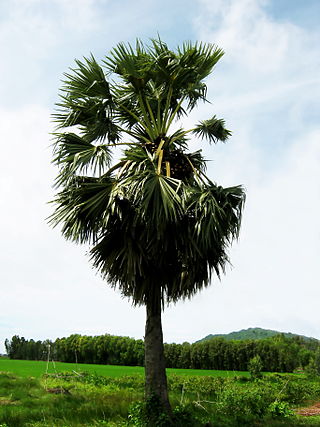
Borassus flabellifer, commonly known as doub palm, palmyra palm, tala or tal palm, toddy palm, lontar palm, wine palm, or ice apple, is a fan palm native to South Asia and Southeast Asia. It is reportedly naturalized in Socotra and parts of China.
Clinosperma bractealis is a species of palm tree in the palm family
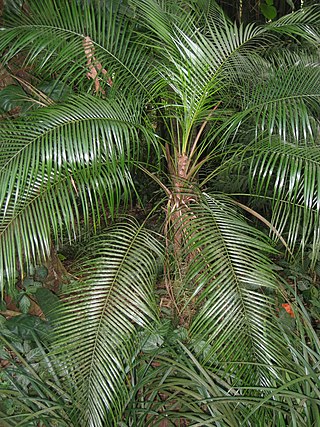
Lytocaryum is a monoecious genus of flowering plant in the palm family endemic to the Atlantic coast of Brazil, where 4 species are known. Palms once classified as Microcoelum are herein included; the genus is closely related to Syagrus, from which it is differentiated only by abundant tomentum, strongly versatile anthers, and slight epicarp, mesocarp, and endocarp differences. The name is Greek for "loose" and "nut".
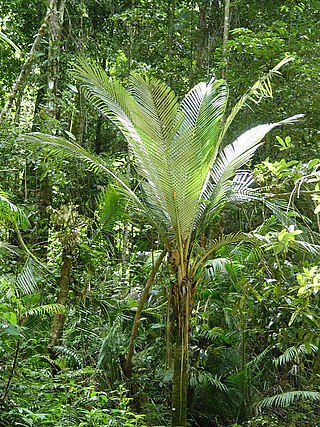
Oraniopsis is a monotypic genus of flowering plant in the palm family from Queensland, Australia, where the only known species, Oraniopsis appendiculata, grows in mountainous rain forest. Dioecious and extremely slow growing, the name means "similar to Orania" and the Latin epithet translates to "appendaged".
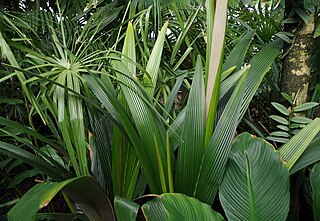
Sommieria is a monotypic genus of flowering plant in the palm family endemic to New Guinea where they grow in rain forest understory. The sole species is Sommieria leucophylla. They resemble the Asterogyne palms but are most closely related to those members of Heterospathe with short stems and sparsely branched inlforescences. The name honors Stephen Sommier, European botanist.
Dransfieldia is a monotypic genus of flowering plant in the palm family from western New Guinea where the lone species Dransfieldia micrantha grows in dense rain forest. Discovered in 1872, 134 years passed before DNA testing revealed its proper placement. With no close relatives, it is a delicate, pinnate-leaved palm named after John Dransfield, former palm expert at the Kew Royal Botanic Gardens.

Butia yatay, the jelly palm or yatay palm, is a Butia palm native to southern Brazil, Uruguay and northern Argentina. It is known as the butiá-jataí in Portuguese in the south of Brazil, as well as simply jataí or butiá. It is sometimes cultivated as an ornamental in Europe and the United States. It is the tallest of all the species in the genus Butia. The fruit is edible with a sweet flavour.

Borasseae is a tribe in the palm subfamily Coryphoideae. The tribe ranges from southern Africa and Madagascar north through the Arabian Peninsula to India, Indochina, Indonesia and New Guinea. Several genera are restricted to islands in the Indian Ocean. The two largest genera, Hyphaene and Borassus, are also the most widespread.

Chuniophoeniceae is a tribe of palms in subfamily Coryphoideae of plant family Arecaceae. The four genera within the tribe are morphologically dissimilar and do not have overlapping distributions. Three of the genera are monotypic, while the fourth genus (Chuniophoenix) has three species.
Saribus chocolatinus is a species of palm tree in the genus Saribus, which is native to Papua New Guinea. It is a fan palm.
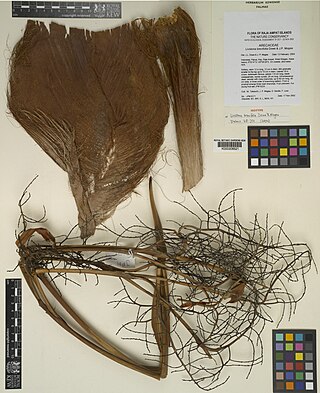
Saribus brevifolius is a species of palm tree in the genus Saribus, which has only been found in the Kawe and Gag Islands in the archipelago of the Raja Ampat Islands, which lie off the north-west tip of the Bird's Head Peninsula in Indonesia's West Papua province. It was only discovered in 2002 during an expedition funded by The Nature Conservancy. The palm grows along the coasts of these two tropical islands on small ridges composed of ultrabasic rock. It is a moderately-sized fan palm with smallish and regularly segmented leaves and a smallish inflorescence in the crown. The inflorescence is not longer than the leaves, and split at its base into three main branches with one or more sub-inflorescences, these containing red flowers with pink anthers. The ends of S. brevifolius leaf segments are rigid and have a bifurcate cleft 1-4% of the segment length.

















